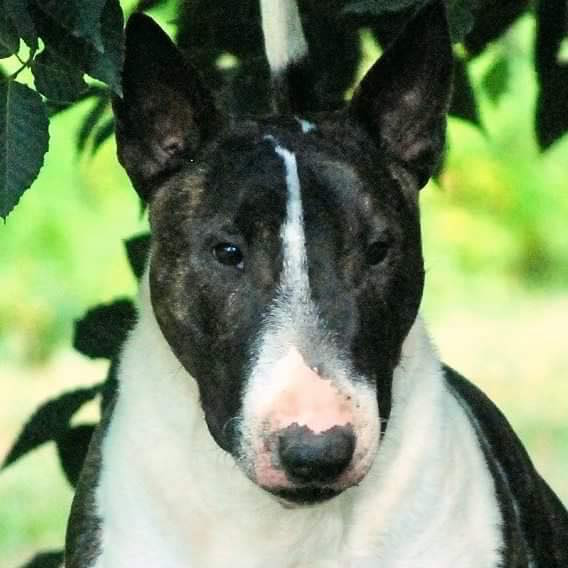
When the Bull Terrier standard reads, “Eyes: Should be well sunken and as dark as possible, with a piercing glint and they should be small, triangular and obliquely placed; set near together and high up on the dog’s head,” the picture at the left is what it’s describing. There is no room for variation here.
Neither is there “wiggle room” for color in a white Bull Terrier. It’s white, though markings on the head are allowed. Anywhere else and it’s to be severely faulted. There is a bit more “play” in the breed standard for the Colored Variety of Bull Terrier: “Any color other than white, or any color with white markings. Other things being equal, the preferred color is brindle.”
That said, Bull Terriers were originally defined by the color white as bred by James Hinks of Manchester, England. We know now that white Bull Terriers do have color – a red or black on red base coat, and a brindle pattern or not) like a Colored Bull Terrier, but the white masking gene known as the S-Locus Series simply covers it and prevents it from being visible.
The illustration on this site reveals how much more complicated colors in this breed is, and knowledge about color in the breed was undoubtedly gained by the work of owners that came before. Thomas Hogarth, a Scottish vet, Bull Terrier breeder and judge, studied the colors of puppies resulting from 340 different breeding and recorded them in books he wrote: “The Coloured and Colour Breeding” and “The Bull Terrier Notebook,” both written in the 1930s. Also published in that decade was, “The Seven Sources of Colour in Bull Terriers,” written by Richard Glyn who would go on to write, “Bull Terriers and How to Breed Them” in 1950. The definitive book on color genetics in the breed, however, may be a textbook written by Clarence Little, “The Inheritance of Coat Color in Dogs.”
Photo by Pam St Raymond
